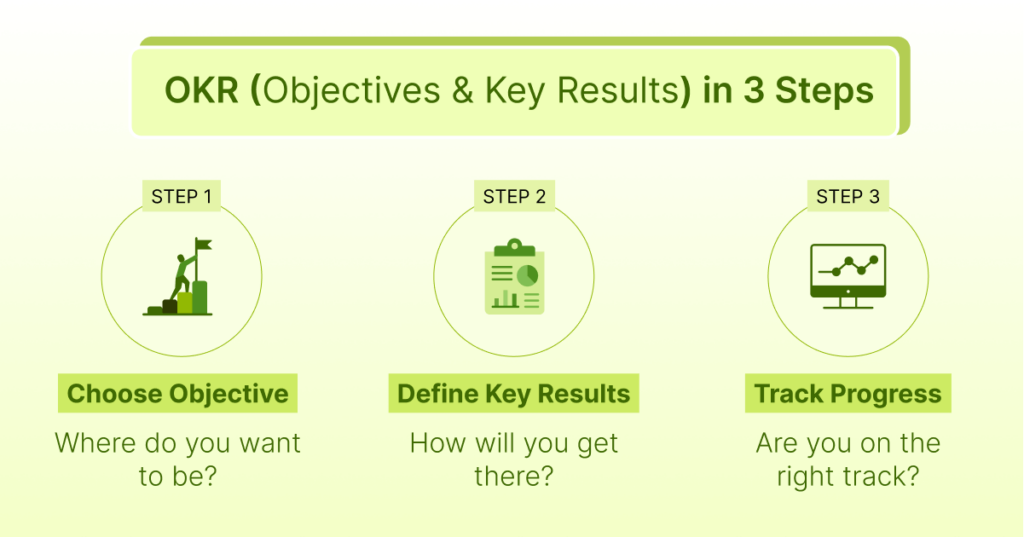Objectives and key results are a structure for people and organizations to develop and track goals and achievements. OKRs help you sync your efforts and align everyone towards the same goals. OKRs also effectively monitor your work performance. Let’s find out how to create clear objectives and identify specific key results.
Also Read:- Chief Technical Officer
What Are Objectives And Key Results?
The Objectives and Key Results (OKRs) structure is a great tool for helping teams and organizations define and achieve goals. An objective is a clear and inspirational goal that you want to achieve. It should be aspirational but attainable so you get guidance and motivation.
Key results are particular and measurable outcomes that show progress toward the objective. Usually, each objective consists of three to five key measurable and time-bound results. Breaking down the Objective into smaller and practical tasks makes it easier to track progress and maintain focus.
In a research, it was discovered that over 83% of organizations reported getting benefits from implementing OKRs. It helped them to respond faster to market developments as 67% of team members believed it is due to OKRs.
The History of Objectives & Key Results OKR
Objectives and key results-based strategy originated in the 1970s when Intel co-founder Andy Grove presented the idea to help align efforts and track success. Grove was inspired by Peter Drucker’s Management by Objectives (MBO) and developed the concept to fit Intel’s fast-paced, high-technology environment.
He emphasized the importance of creating clear and ambitious objectives. Grove also selected specific and measurable outcomes (Key Results) to monitor progress and success.
OKRs gained popularity in the 1990s when former Intel employee John Doerr introduced them to Google. In 1999, Doerr introduced OKRs to Google’s founders, Larry Page and Sergey Brin. They adopted the structure of OKR. OKRs were important to Google’s quick growth and success, and they helped to maintain alignment and concentration as the company expanded.
Progress Of OKRs
Since then, OKRs have been used by several well-known organizations like LinkedIn and Uber. The framework’s simplicity has made it a popular choice for businesses in a lot of industries. OKRs assist teams in prioritizing tasks and increasing openness. This makes sure that everyone is working toward common goals.
How to Set OKRs in Your Organization?
You need a systematic strategy to get alignment and successful tracking when setting up OKRs in your organization. Here’s how you can do it:
1) Define Your Objectives
Objectives are broad, aspirational aims that provide a clear direction. They should be ambitious yet feasible, inspiring your staff to strive for excellence. To define your objectives:
- Commit the leaders to check the top priorities.
- Make sure that objectives are consistent with the organization’s mission and vision.
- Always talk about the objectives clearly to all team members.
2) Identify Key Results
Key Results are measurable outcomes that show progress toward the objectives. Each target should produce 3-5 important results. To identify key results, you should:
- Concentrate on quantitative indicators like sales targets and project milestones.
- Make sure that the key results are both hard and attainable.
- Use numerical figures or percentages to make progress tracking easier.
3) Align and Cascade OKRs
Aligning OKRs throughout the organization makes sure that everyone is working toward the same goals. To coordinate and use OKRs:
- Hold meetings to debate and agree on OKRs at all levels.
- Encourage teams to create their OKRs that support the organization’s objectives.
- Make sure that there is transparency by distributing OKRs around the organization.
4) Monitor and Review Progress
Regularly tracking and reviewing OKRs helps to keep focus for changes. To track and review progress:
- Schedule regular check-ins such as weekly or biweekly meetings.
- Use OKR software or tools to monitor progress and update important results.
- Encourage feedback and discussions to resolve issues and recognize successes.
5) Reflect and Adjust
At the end of the OKR cycle, check what was done and what could be improved. To reflect and adjust:
- Conduct a meeting to check the OKRs.
- Analyze successes and pinpoint areas for growth.
- Use the results acquired to create more effective OKRs for the following cycle.
5 Good Examples Of OKRS
Here are some OKR objectives key results examples:
1) Marketing Team
The objective of the marketing team is to increase brand awareness.
Key Results:
- Achieve a 25% increase in website traffic by the end of Q4.
- Get 10,000 new fans on social media sites.
- Publish 15 high-quality blog posts with at least 1,000 views each.
2) Sales Team
The objective of the sales team is to increase quarterly sales.
Key Results:
- Boost quarterly revenue by 20%.
- Gain 50 new company customers.
- Increase the average transaction size by 15%.
3) Product Development Team
The goal of the product development team is to introduce a new product feature.
Key Results:
- Finish developing and testing the new feature by the end of Q3.
- Get 95% client satisfaction throughout beta testing.
- Get 1,000 active users during the first month of introduction.
4) Customer Support Team
The objective of the customer support team is to improve customer satisfaction.
Key Results:
- Reduce the average response time of customer inquiries to less than two hours.
- Increase the customer satisfaction (CSAT) score to 90%.
- Resolve 85% of customer problems on the first encounter.
5) The Human Resources Team
The goal of the human resources team is to improve employee engagement.
Key Results:
- In the annual survey, rank employee engagement at 80% or higher.
- Do at least four team-building activities each quarterly.
- Reduce staff turnover to less than 10% each year.
Benefits of Objectives And Key Results
Why should you use OKR for your team? Here are some benefits you can get by using objectives and key results:
1) Alignment & Focus
OKRs help people and teams align their activities with the organization’s overall goals. This makes sure that everyone is working toward the same goals which minimizes misalignment and conflicting efforts. Clear objectives give a defined direction which allows you to focus on what’s most important.
2) Measurable Outcomes
OKRs define measurable key results as a clear mechanism to track progress and success. This quantitative method helps teams to objectively know about their performance and make data-driven decisions. Regular measurement helps to identify areas for growth and acknowledges accomplishments.
3) Transparency and Accountability
OKRs increase transparency inside an organization by making goals and progress accessible to everyone. This openness develops an accountability culture since people and teams understand what is expected of them. People can see how their contributions affect overall goals which promotes accountability and ownership over tasks and outcomes.
4) Flexible and Adaptable
The OKR framework is adaptable to meet many organizational needs and changing conditions. Regular reviews and check-ins help with revisions and realignment of goals as needed. This adaptability makes sure that objectives are relevant and achievable even in unpredictable situations.
5) Better Engagement and Motivation
OKRs engage and motivate people by defining specific goals that are both tough and attainable. When people see their progress and understand how their effort contributes to bigger goals, they are more likely to feel invested and motivated to achieve. This sense of purpose can lead to increased engagement and productivity.
6) Improved Communication
OKRs improve communication within teams and throughout the organization by providing a way to share goals and progress. This structured framework promotes regular discussions about priorities and accomplishments. This helps improve collaboration and understanding among team members.
7) Strategic Planning
OKRs help with strategic planning by dividing long-term goals into attainable and short-term objectives. This systematic technique helps companies in developing clear roadmaps for accomplishing their goals which makes sure that day-to-day actions are consistent with larger strategic goals. It helps with better resource allocation and priority.
8) Continuous Improvement
The continuous nature of OKRs encourages continuous improvement among team members. Regularly creating and changing objectives and key results helps organizations to constantly know their performance and look for ways to improve their processes and outcomes. This continuous cycle of review and improvement helps companies to remain competitive and responsive to change.
10 Tips for Setting a Good OKR
Here are 10 simple tips you can use to set up a good OKR:
1) Align With Strategic Goals
Make sure that your objectives and key results are aligned with the organization’s overarching strategic goals. This alignment helps in keeping a consistent direction across multiple teams. It makes sure that all initiatives support the organization’s overall mission and vision.
2) Make the Objectives Clear and Inspiring
Create clear and inspiring objectives. They should be simple to understand and should motivate the team by defining a compelling goal that is both ambitious and achievable. Inspirational goals increase excitement and dedication which puts the teams on a path to achieve exceptional results.
3) Focus on Measurable Key Results
The key results should be measurable and time-bound. Use quantitative measurements to track progress and check success requirements. This approach helps with objective evaluation and in identifying areas for improvement.
4) Limit the Number Of OKRs
Keep the number of OKRs moderate. Each team or person should have no more than 3-5 Objectives, each with 3-5 Key Results. Limiting the quantity makes sure that there is focus and avoids overcommitment. This way, teams can focus on what is genuinely important.
5) Include Team Members in Setting OKRs
Engage team members in the OKR-setting process. This inclusion encourages a sense of ownership and dedication to the goals. When team members have a say in knowing their OKRs, they are more likely to be motivated and involved in meeting them.
6) Make Sure OKRs Are Challenging but Realistic
OKRs should be both challenging and practical. They should push teams beyond their comfort zones. This mix of challenge and achievability promotes progress while preventing burnout. Challenging OKRs encourages innovation and creativity among team members.
7) Regularly Review and Update OKRs
Set up regular check-ins to know and update OKRs. This technique helps track progress and make required changes. Regular reviews make sure that OKRs are still relevant and in line with any changes in organizational priorities or other conditions.
8) Promote a Culture of Transparency
Make OKRs obvious throughout the organization. Transparency encourages accountability and allows everyone to see how their effort fits into the bigger goals. It also creates a collaborative environment in which teams can help one another achieve common goals.
9) Use OKR Software or Tools
Use OKR software or tools to simplify creating and reviewing OKRs. These tools can give you access to dashboards and statistics to aid in progress tracking. Using these technologies helps you know that OKRs are managed consistently and efficiently across the company.
10) Celebrate Success and Learn From Failure
Celebrate your success and learn from your failure. This technique raises morale and gives useful information for future goal planning. Learning from success and mistakes helps fine-tune the OKR process and improve performance.
Conclusion
OKRs are a powerful goal-setting framework that defines and tracks objectives and their results. Objectives are clear and inspiring goals, while Key Results are specific and measurable outcomes that show progress. You can make sure that everyone stays focused and motivated by regularly reviewing and updating OKRs. This guide gave you a good understanding of how to effectively set and manage OKRs.
FAQs
What Is an OKR Software?
OKR software is a solution that helps firms to deploy and manage their OKR process more successfully. OKR software has features like goal-setting templates and reporting options.
How Many OKRs Should I Set?
When developing OKRs, keep the organization’s level in mind. It is recommended to define 3-5 quarterly objectives per quarter each with 3-5 results. This strategy helps to keep the focus on the most important priorities.
What Are the Benefits of OKRs?
Five great benefits of OKR’s are:
- Focus
- Alignment
- Commitment
- Tracking
- Stretching








